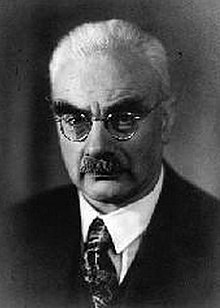Frederik van Iterson
Frederik Karel Theodor van Iterson (born March 12, 1877 in Roermond , † December 11, 1957 in The Hague ) was a Dutch civil engineer.
After graduating from high school (1895), Frederik van Iterson studied mechanical engineering at the Polytechnic in Delft with his diploma in 1899. He then worked at the Conrad shipyard in Haarlem , where he was employed, among other things, for dredging work in the Guadalquivir (and Learned Spanish). In 1903 he went to the public utilities of The Hague and in 1905 he moved to the gas works in The Hague. After his first publications and given his good reputation as an engineer, he was asked to give lectures on applied mechanics in 1908 and in 1910 he became a professor at the TH Delft. He also taught at the Rotterdam School of Commerce.
From 1913 he was director of the then state mining company DSM . The Wilhelmina mine was in operation at the time, the construction of Emma in Brunssum was completed, the Hendrik mine was under construction and Maurits was in the planning stage. Iterson had the use of coke oven gases for town gas expanded and electricity power plants built. He also redesigned the shafts in the mining industry as tower shafts made of reinforced concrete. The number of chemical products was expanded and DSM entered the nitrogen fixation business.
He is known for designing cooling towers for power plants in the form of hyperboloids made of reinforced concrete, a form that later became widely accepted. It was decided to build such a cooling tower for the first time in 1915 for the state coal mine Staatsmijn Emma. They existed from 1918 to 1985. He also registered patents for them.
Hyperboloid tower structures made of steel were developed by the Russian Vladimir Grigoryevich Schuchow at the end of the 19th century .
In 1945 he founded the engineering office Tebodin, which was taken over by the Hollandse Beton Groep (HBS) in 2002 and by Bilfinger in 2012 .
In 1930 he received an honorary doctorate from the TH Delft and in 1934 a member of the Dutch Academy of Sciences.
literature
- Karl-Eugen Kurrer : The History of the Theory of Structures. Searching for Equilibrium , Ernst & Sohn 2018, p. 751ff and p. 1010f (biography), ISBN 978-3-433-03229-9
- HW van Tijen, Levens report FKTh. van Iterson , in: Jaarboek KNAW, 1957–1958, Amsterdam, pp. 220–228 (pdf)
Web links
| personal data | |
|---|---|
| SURNAME | Iterson, Frederik van |
| ALTERNATIVE NAMES | Iterson, Frederik Karel Theodor van |
| BRIEF DESCRIPTION | Dutch civil engineer |
| DATE OF BIRTH | March 12, 1877 |
| PLACE OF BIRTH | Roermond |
| DATE OF DEATH | December 11, 1957 |
| Place of death | The hague |

